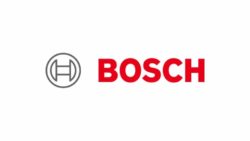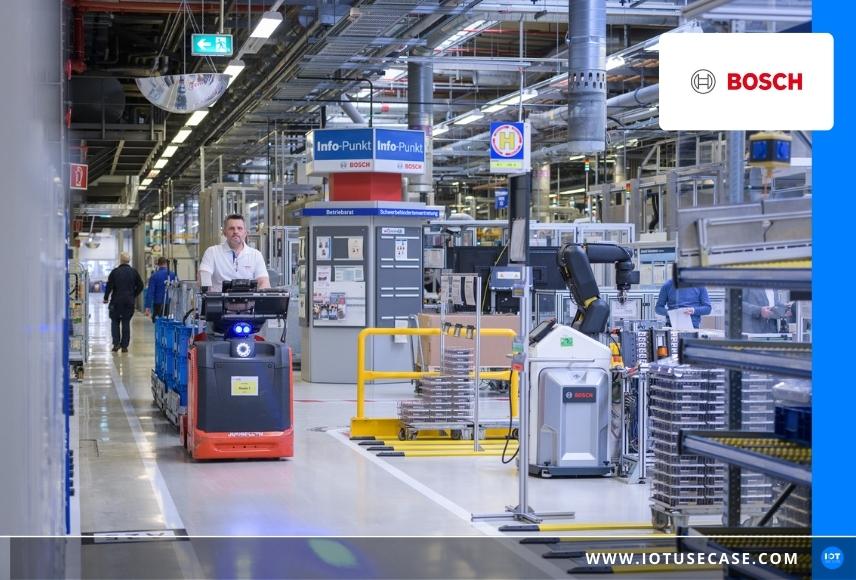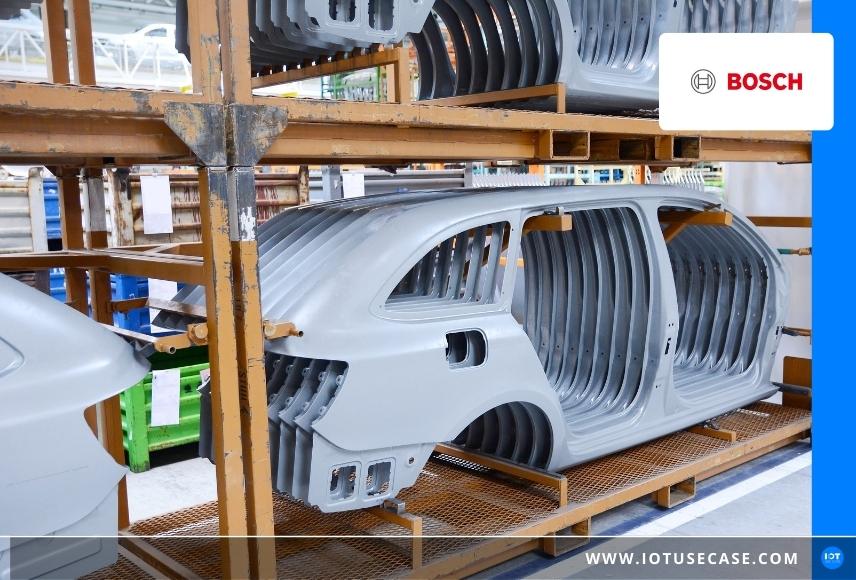Find out how a milk run in intralogistics becomes a “milk flow” and why historical data is the future of production in the 45th episode of the IIoT Use Case Podcast. Madeleine Mickeleit invited two experts for digitalization projects: Julia Hayer (Product Owner Intralogistics) and Fabian Utz (Product Owner Manufacturing – Analytics) from Bosch Connected Industry.
Podcast episode summary
Bosch Connected Industry is the IIoT software house of Bosch. In line with Bosch’s lead user and lead provider strategy, the software and services under the NEXEED name are in use at Bosch plants as well as by international customers. The goal is the efficient digitalization of manufacturing and intralogistics. This podcast episode illustrates how this is implemented in detail using two digitalization projects from practice.
Use Case 1 – Intralogistics: The discussed use case is about transport management in the internal material flow. Especially in intralogistics, paper-heavy and manual processes predominate. Fluctuating transport requirements and capacities constantly present employees with new challenges. Here, automated transport management brings light into the darkness and makes the material flow transparent, optimizing loading states and transport routes. Based on real-time data of current transport needs and available vehicles, the routes of the milkruns are calculated and sent to a tablet. The milkrun driver is informed and instructed on what to do and in what order. This makes intralogistics processes much more efficient and simplifies employees’ daily work.
Use Case 2 – Manufacturing: Manufacturing is still a step ahead of intralogistics in terms of digitalization. However, according to our podcast guests, it is important to harmonize data so that all parties can access the same file formats and transparent, understandable information. An application from the automotive sector is described. The challenge: Information and data can often only be viewed decentrally on one line and are not available across the board. This often stands in the way of a transparent, efficient and error-free production process. Which digital approaches are used here and how condition-based maintenance can be implemented is described in detail in this podcast episode.
Who are the digitalization solutions from Bosch Connected Industry aimed at? The customers are operators of all kinds of production facilities, e.g. manufacturers of materials, spare parts, of complete products or also machine and plant manufacturers. The NEXEED portfolio is used in a wide range of industries – from automotive to electronics and measurement technology to sensor technology. One decisive advantage is that Bosch is its own customer and can extensively test and optimize all solutions in practice at its own plants before offering them to customers on the external market. The extensive experience gained from internal application thus benefits customers and their employees both in technological implementation and in further project support.
Podcast interview
Hello Julia, hello Fabian, welcome to the IIoT Use Case Podcast. First of all, thank you for joining us and taking the time. I would say that we will start with a short round of introductions in order to perhaps also briefly classify where exactly Bosch Connected Industry comes from and how exactly you are active in the Bosch environment. I would just hand it over to you there, Julia. Would you like to say a few words about yourself and Bosch Connected Industry?
Julia
Hi Madeleine, thank you very much for the invitation. I am very happy to be here today. My name is Julia Hayer and I am a Product Owner for Intralogistics at Bosch Connected Industry. Bosch Connected Industry is the software house within Bosch for Industry 4.0 solutions. This means that everything that is needed for transparent, efficient production and intralogistics comes together at our company. But we can go into more detail about that later.
Ok, perfect. Fabian, then I would just hand over to you. Would you like to close the introductory round and briefly say something about yourself and where exactly you are active at Bosch Connected Industry?
Fabian
Hello Madeleine, I am also very happy to be there today. My name is Fabian Utz. I’m a product owner in manufacturing at Bosch Connected Industry, where I’m responsible for areas such as applications for data analysis or condition monitoring, for example. And this entire portfolio that we offer at Bosch Connected Industry is called NEXEED. Under this name, we offer software and services for industrial digitalization. This ranges from retrofit solutions for existing plants to application-specific applications and comprehensive consulting – all from a single source. We support small national companies, but also large corporations that operate internationally.
Thank you very much. I would also go into detail again in a moment about what NEXEED means exactly in practice. Maybe to get into the topic very simply: You are now working with different customers, you just said it, larger, smaller customers. With regard to the topic of Industrial IoT, digitalization and all these buzzwords, I would be interested to know what you see as current developments on the market? Also, what might be the driving factors as to why you guys are going in this direction with customers as well?
Julia
Yes, you’ve already said it. So a very big topic in logistics is digitalization. At the moment, logistics is still very paper-heavy and manual. So, for example, picking lists are printed out according to which the employees work, or the Milkrun driver simply drives through the plant according to the “Go and See” principle and looks where he has to deliver material. Where can I pick up empties, for example? And the first step now is to gain transparency over processes in logistics through digitalization. And based on this, you can then optimize the processes in the next step. And in addition, there is another trend: automation through autonomous transport vehicles. But that’s still very much at the beginning in logistics and I think, Fabian, in manufacturing, you’re already a whole step further with automation.
Fabian
Yes, exactly, digitalization itself is largely complete there. Machines and processes have connectivity. Machines are connected, feeding their data into systems. There is still the issue of harmonization, that you feed the same data formats into systems, for example. Use case specific visualizations are widely available, experts can perform visual analysis. And now it’s very interesting to support experts that they no longer have to do visual analysis themselves, but that process anomalies or machine failures are detected by the system itself. And this is done, for example, with machine learning methods. And the key point here is not to pursue lighthouse projects and do project-specific implementations, but to make AI available in a standardized way and make that easily accessible to manufacturing experts without them having to bring algorithm knowledge, for example.
You are, after all, with Bosch Connected Industry, as you just said, a software house at your company. Can you put this in the overall context of Robert Bosch GmbH and perhaps also establish the context of the historical development on the part of Barsch Connected Industry? Maybe you can elaborate a little bit on which customers you work with there? Is it the Bosch plants or is it international customers? Just to have a little bit of a general idea from the beginning.
Fabian
There it might be important to know – where do we come from? So long before Industry 4.0 or IoT was coined, solutions from the NEXEED area, from the NEXEED portfolio, were already in use at Bosch. The Nexeed MES, for example, has now been in use for more than 20 years and is used at almost half of all the approximately 240 Bosch plants worldwide – and the trend is rising. The same applies to the Nexeed Automation and the Control Plus control software. In parallel, many software solutions were developed and tested internally, and Bosch always pursued the strategy of being both a user and a provider in Industry 4.0. This means that solutions are developed internally, used by the company itself, and then, for example, provided to the external market. And this strategy, culminated in 2018 with the creation of Bosch Connected Industry and the external launch of the NEXEED portfolio.
Are these primarily the plants where your solutions are used, or which customers do you still work with in detail, Julia?
Julia
Yes, for one thing. So we have the internal customers with us, but everything that has been extensively tested and validated internally with us, that is then also available to the external customers from different industries. For example, manufacturing operators, machine builders and intralogistics specialists, who then benefit from Bosch’s experience and expertise. Today, we have a total of about 100 international customers using the solutions from our NEXEED portfolio. And it is used in various industries, e.g. automotive, electronics, metrology, sensor technology, to name just a few. And to sum up, our customers are operators of all kinds of production facilities, e.g. manufacturers of materials, of spare parts, of complete products, or also manufacturers of machines and plants. The solutions are suitable both for a greenfield deployment, i.e. when someone builds a new plant, that we are there right from the start and accompany the introduction. But you can integrate it just as well into existing plants.
Now, both of you have already addressed the area of logistics, as well as production and manufacturing. This brings with it different fields of application where use cases are developing, also in the direction of digitalization, in the area of IoT. You have the slogan “We digitalize your value chain”. What does that mean in detail and what are perhaps the challenges of these individual areas? So somehow you have development, procurement, manufacturing, intralogistics and many more areas. What are the challenges or needs here in practice?
Julia
Yes, the current challenges at Bosch, and I think at many other manufacturing companies as well, are that we simply have fluctuating customer orders. We have supply bottlenecks with suppliers and, above all, the problem with short-time working. And it is said that this means that this long-term planning security no longer exists and the complexity in material supply increases extremely. At our Bosch plants, we have simply noticed that this complexity can no longer be managed without intelligent systems.
Okay, now I’d like to get into the practice a little bit. So I always talk about different use cases in the podcast. Now we have addressed logistics. I would like to stay with the example of a classic flow of goods. Can you give listeners a virtual picture of what it’s like on site with your customer? How do you have to imagine such a process in intralogistics in order to get into the next step a bit about the jobs and the data and then talk a bit about the solutions.
Julia
The goal of our intralogistics solutions is first of all to make the material flow transparent and then, as I said, to support employees so that they can handle this increasing complexity in intralogistics. We have developed two solutions for this. This is stock management, for one thing. The Stock Management application provides a digital twin to make stocks in production transparent. But today I would like to focus on the second solution. This is the transport management for the internal transport of goods.
If you imagine the internal transport of goods in a visualized way, what do classic jobs look like here, and perhaps also which demand drivers or stakeholders are still involved? How do you have to imagine this to work on a day-to-day basis in the internal transport of goods?
Julia
Yes, if you look at logistics, first of all there are the planning tasks. This means that there is a logistics planner who is responsible for planning and designing the milkrun routes, but also for capacity planning. That is, which employee works where, how many vehicles do I currently have available, and when he does, it is usually so up-to-date that he does it with elaborate calculations in Excel, for example. But there is little support in tools to perform this planning task. And the main task in logistics is, of course, physical transportation, i.e. getting the material from point A to point B.
Exactly such Excel tables one finds of course in abundance that there is still much manually documented. How exactly do you have to imagine this transport management process? How exactly is it supported today? How does this work in practice?
Julia
Yes, it is always difficult for the employee if, for example, he has fluctuating transport requirements or if the same capacity is not always available, because then he reaches his limits with the Excel spreadsheet. This means that he would actually have to permanently recalculate what the milkrun route currently looks like. And the transport management system makes this calculation automatically on the basis of the current transport requirements and the available vehicles. I.e. this relieves the planner in his work. The calculated tours are then sent directly to a tablet that the Milkrun driver has on his vehicle. This means that the driver is then guided step by step through his tour and the tablet explains what he has to do at which station. And this then also makes it possible to deploy employees flexibly. So you can, for example, put people who don’t normally work in the field, for example, vacation replacements or any floaters on a route like that because they practically have these step-by-step instructions on their tablet.
Okay, if I now look at a classic transport route, what data or key figures are interesting for your customers? I’m just imagining now what you just said figuratively. What systems are in use here and how do you record which data in the field?
Julia
Of course, we have interfaces to other systems, i.e. to the source systems such as SAP or MES. From the systems we then get the transport requirements and in addition the user also has to create the material master data and give the information about the fleet. So practically what vehicles are there in the plant, what trailers, what load carriers? And based on this data and the live data from the plant, i.e. the current position of the vehicles and the free loading area, the milkrun tour is then planned.
That sounds relatively complex, and the MES system already provides a lot of data. If I now think about the whole thing a bit further and really go in the direction of data analytics: How do I bring the knowledge that has been formed through these different routes or from these individual systems, how do I bring these competencies into the digital? There are already many different competencies available through processes, in Excel spreadsheets for example, but perhaps also in other systems. How exactly do I bring this knowledge into the digital now? How does it work?
Julia
This is an important step. All the know-how that people have in their heads and in their Excel spreadsheets has to be transferred to our application somehow. And we do this at Bosch Connected Industry together with the Bosch plants, simply because we have so many locations worldwide. We are simply fortunate that we can draw on the process know-how and develop new functions on that basis. And these functions are always tested directly in the pilot plants. That means we develop, there is a new function, it is tested and validated in the pilot plant. This means that the plants give us feedback as to whether the function is suitable for stable use in production. And only when that is given, it is then also released and practically released for other customers.
Now people often talk about the business model, the business case behind it. In the end, supply bottlenecks have to be bridged somewhere, there has to be long-term planning, you have to remain competitive. Of course, the issue of costs plays an incredibly important role here. What does the business case look like in practice for this very specific case in logistics?
Julia
Yes, we can realize the business case by planning on the basis of real transport needs. This means that we can dissolve the static Milkrun routes and the Milkrun train no longer runs according to a static bus timetable, as it used to, where it really travels to all stations. Instead, we know exactly at which station there is currently a need for transport and we use this tablet to direct the train only to the stations where there is really a need, which allows us to significantly increase efficiency. In addition, we then have live over-scheduling. This means that we always know exactly where which milkrun is currently located. And when a new transfer order enters the system, we first check whether it still fits onto a current route that is on its way. And if that’s the case, we plan for that right away. This means that we can also significantly increase the utilization of the vehicles.
A quick question: Of course, the topic of real time plays an incredibly relevant role, doesn’t it?
Julia
Yes, definitely. That’s why we have this tablet. On the one hand, it is the display for the driver, but at the same time it is also the feedback to us. Whenever the employee acknowledges something, e.g. when he has arrived at the station or when he has delivered something, the information comes directly live into our system and is used again for the rescheduling of the route.
If I now move a bit away from this logistics topic to production, Fabian. You had said that you now have many customers who are also operators of such production facilities. You said at the very beginning that it’s also about data analytics somewhere. How do you see it now – moving away from logistics to production? How does this work in practice?
Fabian
In production, you move away from the flow of materials naturally to the machine. How is the machine? What can I optimize on the machine? It’s all about processes: What processes are running on the machines? Are they stable? Are they unstable? What do I have to do to achieve the highest possible quality here? And then, of course, the final products, the product quality at the end, which should be quite high, preferably, of course, without defects. We are addressing the process experts and the quality engineers, but also the machine maintenance engineers. And they naturally want a transparent, error-free, continuous process for the products, which then ensures perfect quality. And deviations should be detected quickly. These should be easy to analyze, so that all the deviations can be reduced to a minimum. And the result should be efficient production with high plant effectiveness. And that is exactly why we have put together the Product Quality package, to cover precisely these requirements in the final analysis.
Now we had also talked with Julia about the challenge in logistics. So what about the classic challenges you find in these processes on the machines? Now you had just talked about product quality, quality assurance is a relevant point. How do you have to imagine this? What are the day-to-day challenges of your customers here?
Fabian
Yes, first of all it’s about connectivity. I mentioned that earlier. You’re out of the woods, there are solutions. If I look at an automotive manufacturer now, they have different processes that they do on the body, such as bolting. And we have hundreds of screwdrivers in the plant, and the results should of course be centrally visible somewhere, and currently they are often only visible locally on the line. That’s where the customer has to run to, and it’s also about analytics across devices. How stable are my processes? Do certain devices cause problems? Where can I optimize? These are the main issues we face.
If I now stay with this example with the screwdriver. What data is interesting in this very specific use case or in this application, in order to perhaps generate further insights for possible digital solutions?
Fabian
If you imagine a screwing process like this, then you have a rotation angle. So how far do I turn a screw in, for example, and also a torque, so how tight is the screw tightened at the end. And there are very, very specific requirements in these processes. How exactly the angle should be, through which windows this curve should go. And the data is very, very important in the use case to define at the end, is the process result okay or not. That is, if this screwing process is accepted, the screw is properly screwed in or not. But also in other use cases, such as pressing or welding, process curves can be evaluated in the system almost in real time. And that’s where the analysis, the visual analysis and the transparency is very, very important first of all. We also monitor plants themselves – for example, we monitor various components of the entire plant at a customer’s coating facility using cathodic dip painting with individual rules that can be set via the software interface in order to implement condition-based maintenance, for example. And this logic is transferable to different use cases. This means that we have a very broad spectrum that we can cover.
Now, if I stay with the example again, which is the cathodic dip alloy, I have, as you said, different components, different data that are monitored. Now I have to somehow convert this intelligence from the process to the digital. It’s about analyzing the data. How do you have to imagine this in practice? How does this analysis of the data work? As a customer, do you collect them first and then see what insights you generate from them? How does this work in detail?
Fabian
So the approach that has been followed for a long time is, for example, for a specific machine, for a specific component in a specific project, to create algorithms, with Data Scientist, with experts, who can then predict, for example, the part quality or a failure. We are now moving away from this and saying: We want to develop algorithms, also internally at Bosch, which then go to historical data – 2, 3 weeks, 4 weeks even longer, over half years, years. When you talk about machine failures, I don’t have a machine failure every day. You simply need a certain history of data so that you can make valid and accurate statements with algorithms like these. And we have worked very, very closely with our customers, with process experts inside and outside Bosch over the last few years. Here, we have the advantage that precisely these experts are located at our plants to implement, for example, event sequence detection, which is now standard in the product. And if any machine failure happens on the machine and I also have quite a lot of other events on a machine e.g. the oil pressure goes up or the door is opened, then I can use an algorithm here to detect the relevant event sequences and prevent them in the future. That is, I know what sequences happen before a machine failure occurs. Nowadays, with this abundance of data, it is simply no longer possible as an expert to just estimate, but you simply need supporting tools that the experts can then use to make their daily lives easier.
I think the point that you said is insanely important to also just put these event sequences side by side and then look at what occurs how often and how can you save that in the end. This is an insanely important point. Now Julia had just said, there is also a dashboard somewhere, a tablet, where you can see information. What does this look like for the user specifically in the NEXEED Industrial Application System? Suppose I now have sequences of events that I want to display. What exactly does it look like in the system?
Fabian
First of all, of course, I see the parameters, I can visualize them, e.g. via a historical diagram. There I see the progressions, see first only the data visualized. Then I can apply logic to it, e.g. standardized rules or this event sequence recognition. And it is important to create accessibility for the experts, so that I no longer have to program an algorithm on the surface, but that I can use prefabricated building blocks and apply them to data and also connect my expert knowledge with the system. In other words, the experts feed the system, the system feeds the expert, and in this way the processes can be optimized step by step. And I can also, for example, analyze these events historically. I can draw myself a Pareto chart and so on, that you can close these insights that you generate, back over the cycle. In the end, I want to generate an action from all these insights – on the shop floor, in production, where I then change the oil, for example, because otherwise the machine would be at a standstill in two days, or adjust a process parameter because otherwise the process would become unstable. And that’s where I want to be proactive, not reactive.
Now, when you talk about the expert knowledge or the events that I also want to optimize little by little through such a system, what are the top factors that helped you to implement these projects in the first place? First of all, it is a relatively complex topic for customers, or a complex project to implement holistically. What are the classic factors that have helped you in practice to implement this successfully with customers? Julia, I’m looking in your direction now.
Julia
We already mentioned earlier that we develop all our solutions together with the Bosch plants and also test them there. And I think this domain expertise that we have in our Bosch plants helps us enormously. So Bosch uses our solutions every day and we get direct feedback. So it’s a bit easier than with an external customer when you test internally first. We know the people, we have our pilot customers. This means that if something doesn’t work or if there are problems, we get direct feedback, which we can then use to further develop the products. And we also have access to these experts. So that means that if we’re doing a roll-out at a customer’s site, at a new plant, we can simply take a logistics planner from Feuerbach, for example, and say: Okay, can you help us out for a day or two? Then we take the expert with us to the customer and he can also provide a little different support there than we can from the software now. So this is simply an employee who knows the shop floor, he has introduced the system himself, he knows the difficulties of implementation and he can simply discuss with the customers at eye level. And I think that’s extremely important in projects like this.
Fabian
As Julia has already mentioned, we use precisely these experts to develop applications in an agile manner and together with the customers. And in this way, we manage to deliver precisely the functionalities with our applications that are also required by the customers and perhaps also to be a little ahead of the times and to know what will perhaps be required on the market in a year’s time. This means that we and our customers are immediately ready for use and have positive results very quickly, which can then also be scaled, because at Bosch we also make sure that we achieve standardization and enable scalability. And in addition to the software solution, we also offer other services. Because from our point of view, holistic consulting around digitalization also includes technical support or employee qualification, professional change support. After all, only if everyone participates in the digital transformation at the end and accepts and supports the new solutions from the very beginning can the journey also lead to a promising future.
Now we’ve looked into two small use cases. Thank you very much for the insights into your customers and the plant structures. Standardization and in-house expertise are also two important points, and I believe that many listeners who are just embarking on this path or already are and are looking for good partners who can help implement such topics holistically will find themselves on this path. Thank you for the exciting session!













